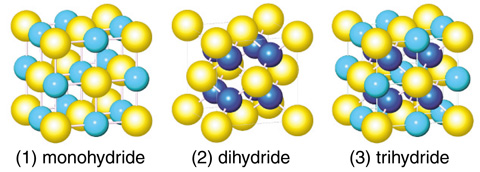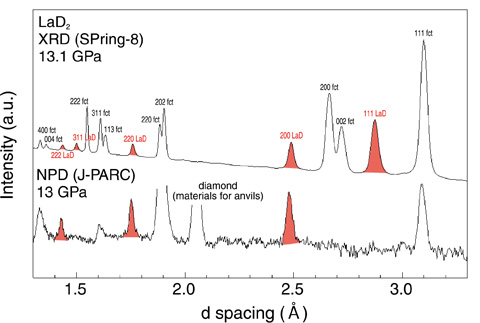
Fig.5-12 Structures of three hydrides with different H concentrations and the fcc metal lattice

Fig.5-13 SR XRD (upper) and NPD (lower) profiles after phase separation of LaD2 at 13 GPa
Rare-earth metals have a very high affinity for hydrogen (H) and form various H-concentration states, starting from a solid solution and ending with the trihydride RH3, through the dihydride RH2. Ideally, RH2 has a face-centered-cubic (fcc) metal lattice in which the tetrahedral (T) sites are filled with H atoms and the octahedral (O) sites remain empty (Fig.5-12(2)). Further absorbed H atoms occupy the O sites, and RH3 is eventually formed (Fig.5-12(3)). However, rare-earth metal monohydrides RH (Fig.5-12(1)), in which only the O sites are occupied by H atoms, has not yet been reported.
Previously, through synchrotron radiation (SR) X-ray diffraction (XRD) measurements at BL22XU, SPring-8, we found that LaH2 decomposed into two different fcc phases at pressures above 11 GPa. The observed decomposition suggests that H-poor and H-rich phases are spontaneously formed by pressurization. To understand this phase separation, information on the interstitial H atoms is necessary.
In this study, we attempted to determine the concentration and atomic positions of deuterium (D) after phase separation of LaD2 by neutron powder diffraction (NPD) at high pressure. First, we developed a high-pressure setup with a Paris-Edinburgh press and then installed it in the high-intensity total diffractometer NOVA at BL21 in the MLF, J-PARC. With this setup, we succeeded in measuring NPD patterns up to 17 GPa, the highest pressure for domestic NPD experiments, at ambient temperature.
Fig.5-13 shows the XRD and NPD profiles obtained at ∼13 GPa. The Bragg peaks of the D-poor phase with an fcc metal lattice are shown in red. One may notice that several Bragg peaks indexed with odd numbers are missing in the NPD pattern for the D-poor phase, while these peaks are present in the XRD pattern. The lack of odd-number-indexed Bragg peaks suggests the formation of an NaCl-type structure due to the comparable neutron scattering length of the La and D atoms. The NaCl-type hydride can be regarded as an fcc monohydride, in which only the O sites are occupied by H(D) atoms. The present result indicates that only rare-earth metals can form a series of stoichiometric hydrides, such as RH, RH2, and RH3, with the fcc metal lattice.
This work has been partially supported by the New Energy and Industrial Technology Development Organization (NEDO) under Advanced Fundamental Research on Hydrogen Storage Materials.